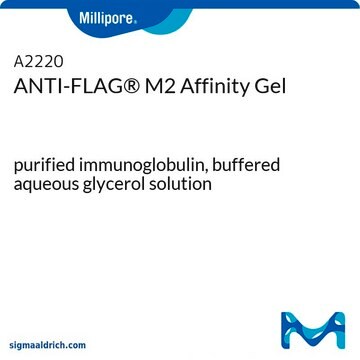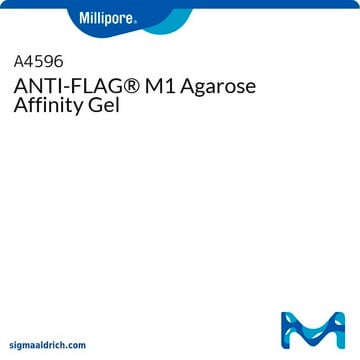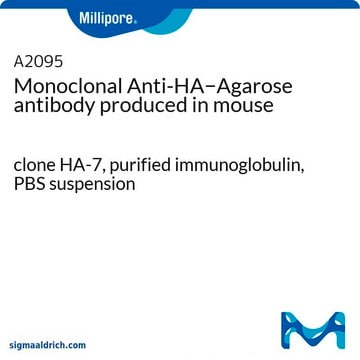11815024001
Roche
Anti-Protein C Affinity Matrix
from mouse IgG1κ
Synonyme(s) :
affinity matrix, anti-protein c
Se connecterpour consulter vos tarifs contractuels et ceux de votre entreprise/organisme
About This Item
Code UNSPSC :
12352203
Produits recommandés
Source biologique
mouse
Niveau de qualité
Conjugué
agarose conjugate
Forme d'anticorps
purified immunoglobulin
Clone
HPC4, monoclonal
Forme
slurry
Conditionnement
pkg of 1 mL (settled resin volume)
Fabricant/nom de marque
Roche
Isotype
IgG1, kappa
Capacité
2-10 nmol/mL binding capacity
Température de stockage
2-8°C
Description générale
Protein C is a Vitamin K-dependent plasma zymogen that is activated by proteolytic cleavage of the thrombin-thrombomodulin complex to form an anticoagulant enzyme. Anti-Protein C mouse monoclonal antibody (clone HPC4) binds specifically to an epitope sequence spanning the thrombin cleavage site of protein C and is immobilized. Anti-Protein C recognizes the 12-amino acid sequence (EDQVDPRLIDGK), which encodes residues 6 through 17 of the heavy chain of Protein C. The formation of the Anti-Protein C/protein C epitope complex is dependent on the presence of calcium ions. In the presence of Ca2+, the antibody binds with high affinity and specificity to this sequence in native human Protein C or in proteins tagged with this epitope. This efficient binding within the recombinant fusion protein occurs regardless of the site of incorporation of the epitope tag (i.e., N terminus, C terminus, or within the reading frame). This unique antibody is especially well suited for purification of recombinant fusion proteins tagged with the protein C epitope.
Monoclonal mouse antibody Anti-Protein C (clone HPC4) is covalently coupled to agarose beads. In the coupling reaction 4mg of antibody is reacted per 1ml of beads.
- Insertion of the protein C tag does not introduce a new metal-ion binding site. The antibody contains the Ca2+ binding site.
- Protein C tag can be integrated either at the N-terminus, C-terminus or internally without any change in antibody specificity.
- Rapid immunoaffinity purification under non-denaturing conditions using economical calcium chelating agent (e.g., EDTA) or alternatively a specific protein C-tag peptide.
Monoclonal mouse antibody Anti-Protein C (clone HPC4) is covalently coupled to agarose beads. In the coupling reaction 4mg of antibody is reacted per 1ml of beads.
Spécificité
Anti-Protein C recognizes the 12-amino acid sequence EDQVDPRLIDGK, which encodes residues 6 to 17 of the heavy chain of protein C. In the presence of Ca2, the antibody binds with high affinity and specificity to this sequence in native human protein C or in proteins tagged with this epitope. Efficient binding within the recombinant fusion protein occurs regardless of epitope position (N-terminal, C-terminal, or internal).
Application
Anti-Protein C Affinity Matrix is used for:
Following immunoprecipitation or purification, the tagged protein of interest may be analyzed by:
- Immunoprecipitation of Protein C-tagged proteins from mammalian, bacterial, and yeast cell extracts
- Affinity column purification of Protein C-tagged proteins from crude protein extracts
Following immunoprecipitation or purification, the tagged protein of interest may be analyzed by:
- Western blotting using the Anti-Protein C antibody
- Silver staining (or similar protein stain)
Caractéristiques et avantages
- use gentle elution conditions using calcium-chelating agents like EDTA.
- highly specific to EDQVDPRLIDGK, derived from protein C.
- binding of Anti-Protein C to protein C-epitop is dependent on the presence of calcium ions.
- suitable for purification of proteins containing protein C as N-terminal, C-terminal or internal fusion.
- applicable with crued cell extracts from mammalian, bacterial, and yeast expression systems.
Contents
1. The antibody is covalently coupled to agarose beads and supplied as a 2ml slurry containing 1ml beads and 1ml buffer.
2. 4mg of antibody is reacted per ml of beads in the coupling reaction.
3. A plastic column with top and bottom caps is included.
Conditionnement
1 kit containing settled resin and column
Qualité
Each lot of Anti-Protein C Affinity Matrix is tested for its ability to purify a Protein C-tagged protein expressed in transformed bacteria from crude bacterial extract. The antibody affinity column is used in combination with western blot and/or silver stain analysis.
Forme physique
1 ml settled resin of Anti-Protein C Affinity Matrix in 20 mM Tris, 0.1 M NaCl, 1 mM CaCl2, and 0.09% sodium azide (w/v); 2 ml suspension equals to 1 ml bed volume. One plastic column with top and bottom caps is included
Remarque sur l'analyse
KD = 10–9 M Binding Capacity is 2 to 10 nmol/ml affinity matrix. Yield of 10.5 nmol purified protein/ml affinity matrix was determined using a whole-cell bacterial extract containing protein C-tagged β-galactosidase.
Autres remarques
For life science research only. Not for use in diagnostic procedures.
Code de la classe de stockage
12 - Non Combustible Liquids
Classe de danger pour l'eau (WGK)
WGK 1
Point d'éclair (°F)
does not flash
Point d'éclair (°C)
does not flash
Faites votre choix parmi les versions les plus récentes :
Déjà en possession de ce produit ?
Retrouvez la documentation relative aux produits que vous avez récemment achetés dans la Bibliothèque de documents.
François Rousseau et al.
The Journal of biological chemistry, 283(44), 30341-30350 (2008-08-30)
Ciliary neurotrophic factor, cardiotrophin-like cytokine, and neuropoietin are members of the four-helix bundle cytokine family. These proteins signal through a common tripartite receptor composed of leukemia inhibitory factor receptor, gp130, and ciliary neurotrophic factor receptor alpha. Binding to ciliary neurotrophic
Takumi Kamura et al.
Proceedings of the National Academy of Sciences of the United States of America, 100(18), 10231-10236 (2003-08-20)
The abundance of the cyclin-dependent kinase (CDK) inhibitor p57Kip2, an important regulator of cell cycle progression, is thought to be controlled by the ubiquitin-proteasome pathway. The Skp1/Cul1/F-box (SCF)-type E3 ubiquitin ligase complex SCFSkp2 has now been shown to be responsible
Mary Anne T Rubio et al.
Nature, 542(7642), 494-497 (2017-02-24)
Nucleic acids undergo naturally occurring chemical modifications. Over 100 different modifications have been described and every position in the purine and pyrimidine bases can be modified; often the sugar is also modified. Despite recent progress, the mechanism for the biosynthesis
Jing Huang et al.
Journal of molecular and cellular cardiology, 66, 157-164 (2013-11-26)
Despite advances in the treatment of acute tissue ischemia significant challenges remain in effective cytoprotection from ischemic cell death. It has been documented that injected stem cells, such as mesenchymal stem cells (MSCs), can confer protection to ischemic tissue through
H Plun-Favreau et al.
The EMBO journal, 20(7), 1692-1703 (2001-04-04)
Ciliary neurotrophic factor (CNTF) is involved in the survival of a number of different neural cell types, including motor neurons. CNTF functional responses are mediated through a tripartite membrane receptor composed of two signalling receptor chains, gp130 and the leukaemia
Notre équipe de scientifiques dispose d'une expérience dans tous les secteurs de la recherche, notamment en sciences de la vie, science des matériaux, synthèse chimique, chromatographie, analyse et dans de nombreux autres domaines..
Contacter notre Service technique








